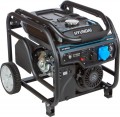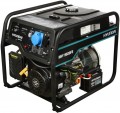Add to comparison |  |  |
|---|---|---|
| Hyundai HHY9050FE | Hyundai HHY9020FE | |
| Outdated Product | Outdated Product | |
| TOP sellers | ||
Company engine. Electric starter. Automatic voltage regulator (AVR). Output 12 V. | HHY9020FE without auto start (230 V), HHY9020FE ATS with auto start (230 V), HHY9020FE-T without auto start (400 V) | |
| Fuel | petrol | petrol |
| Output voltage | 230 B | 230 B |
| Rated power | 6 kW | 6 kW |
| Max. power | 6.5 kW | 6.5 kW |
| Alternator | synchronous | synchronous |
| Alternator winding | copper | copper |
Engine | ||
| ICE type | 4-stroke | 4-stroke |
| Motor type | Hyundai IC420 | Hyundai IC420 |
| Engine size | 420 cm³ | 420 cm³ |
| Power | 15 hp | 16 hp |
| Fuel consumption (50% load) | 1.72 l/h | 1.72 l/h |
| Fuel tank volume | 25 L | 25 L |
| Fuel level indicator | ||
| Starter type | electric starter (key) | electric starter (key) |
| Motor cooling | air | air |
Connection (sockets) | ||
| Total number of sockets | 2 | 2 |
| Sockets 230 V | 16 A x1, 32 A x1 | 16 A x1, 32 A x1 |
| Output 12 V | terminals | terminals |
Features | ||
| Features | automatic voltage regulator (AVR) display hour metre voltmeter | automatic voltage regulator (AVR) display hour metre voltmeter |
General | ||
| Protection level | IP 23 | IP 23 |
| Noise level | 74 dB | 74 dB |
| Dimensions | 725x595x580 mm | 730x570x600 mm |
| Weight | 97 kg | 85 kg |
| Added to E-Catalog | march 2020 | august 2018 |